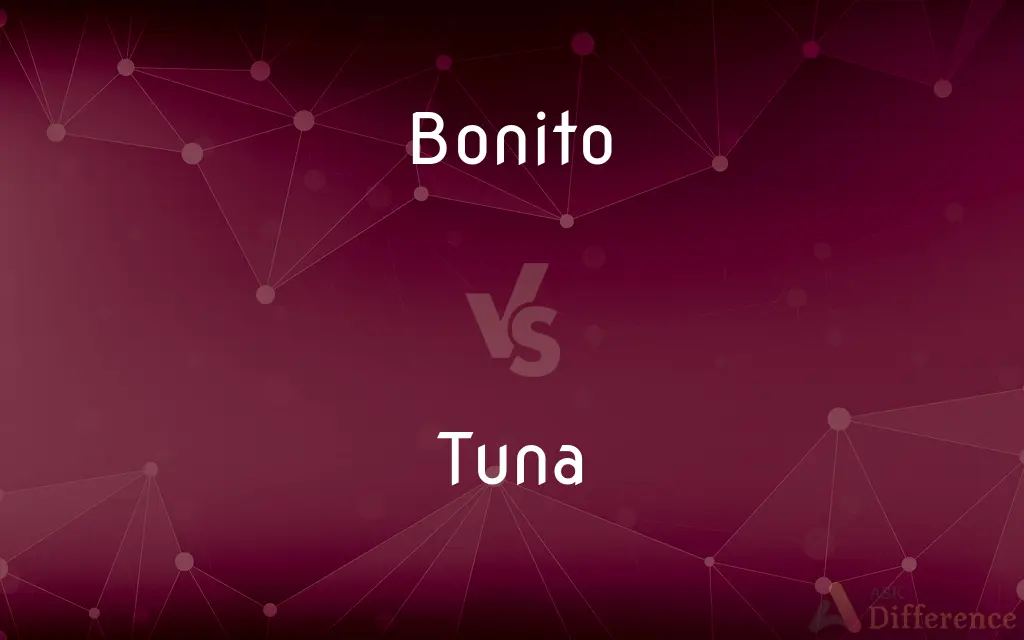Bonito vs. Tuna — What's the Difference?
By Urooj Arif & Fiza Rafique — Updated on March 31, 2024
Bonito are smaller, faster, and have a more pronounced taste compared to tuna, which are larger, vary widely in species, and have a milder flavor suitable for a range of culinary uses.

Difference Between Bonito and Tuna
Table of Contents
ADVERTISEMENT
Key Differences
Bonito, belonging to the Scombridae family, are known for their smaller size and streamlined bodies, enabling high-speed swimming. They are often found in warmer waters and are prized for their rich, strong flavor. On the other hand, tuna encompasses a wider variety of species, including some of the largest marine fish, such as the bluefin tuna, which can grow to be several hundred pounds and are found in various oceanic environments, from tropical to temperate.
While bonito's meat is dark and has a pronounced taste, making it well-suited for specific dishes such as tataki or as a flavor enhancer in stocks and broths, tuna, depending on the species, offers a range of flavors from mild to rich. Tuna is versatile, used in everything from raw sashimi to canned products, making it a staple in both gourmet and household kitchens worldwide.
Bonito, due to their size and the robustness of their flavor, are not as widely consumed as tuna. Their meat is often considered too strong for mild dishes and is instead utilized in cuisines that can accommodate or celebrate its intensity. Conversely, tuna's global popularity owes much to its culinary versatility, with its milder species being particularly favored in Western cuisines, and its fattier varieties, like the bluefin, being highly valued in Japanese cuisine.
The fishing and consumption patterns of bonito and tuna also differ significantly. Bonito are often targeted by sports fishermen and are not fished as heavily commercially as tuna. Tuna, however, are a cornerstone of commercial fishing industries, with certain species being overfished due to high demand, leading to significant ecological concerns and international regulatory efforts.
In terms of nutritional content, both bonito and tuna are rich in omega-3 fatty acids, protein, and various vitamins and minerals, making them valuable parts of a healthy diet. However, the higher fat content in certain tuna species can make them a more sought-after choice for their texture and flavor in culinary applications, compared to the leaner bonito.
ADVERTISEMENT
Comparison Chart
Size and Speed
Smaller and faster.
Larger, varies widely in size.
Habitat
Prefer warmer waters.
Found in tropical to temperate oceans.
Flavor
Strong and pronounced.
Ranges from mild to rich, depending on the species.
Culinary Uses
Suited for specific dishes; used as a flavor enhancer in broths.
Extremely versatile, used from raw dishes to canned goods.
Popularity
Less widely consumed due to strong flavor.
Highly popular and consumed worldwide.
Fishing Patterns
Targeted by sports fishermen, less commercially fished.
Heavily fished commercially, subject to overfishing.
Nutritional Value
Rich in omega-3, protein, vitamins, and minerals.
Similar nutritional value, some species are fattier.
Compare with Definitions
Bonito
Known for their streamlined bodies and preference for warm waters.
Bonito often migrate to warmer waters during summer.
Tuna
A large, widely varied species of fish, popular in global cuisines.
Tuna sashimi is a staple in Japanese restaurants.
Bonito
Often targeted for sport fishing rather than commercial.
Catching bonito is a popular challenge among sport fishermen.
Tuna
Offers a range of flavors, from mild to rich.
Albacore tuna is favored for its mild flavor in canned products.
Bonito
A smaller, fast-swimming fish with a strong flavor.
Bonito flakes are essential for authentic Japanese dashi.
Tuna
Valued for its nutritional content, including omega-3 and protein.
Tuna is a key component of a heart-healthy diet.
Bonito
Their meat is darker and used in specific culinary contexts.
Grilled bonito is a delicacy in Mediterranean cuisines.
Tuna
Essential to commercial fishing industries, with some species overfished.
Conservation efforts are crucial for sustaining tuna populations.
Bonito
Less commonly eaten than tuna due to their pronounced taste.
Bonito is typically preferred by those who enjoy richer fish flavors.
Tuna
Can grow to several hundred pounds and live in diverse climates.
Bluefin tuna are among the largest and most prized species.
Bonito
Bonitos are a tribe of medium-sized, ray-finned predatory fish in the family Scombridae – a family it shares with the mackerel, tuna, and Spanish mackerel tribes, and also the butterfly kingfish. Also called the tribe Sardini, it consists of eight species across four genera; three of those four genera are monotypic, having a single species each.
Tuna
A tuna is a saltwater fish that belongs to the tribe Thunnini, a subgrouping of the Scombridae (mackerel) family. The Thunnini comprise 15 species across five genera, the sizes of which vary greatly, ranging from the bullet tuna (max.
Bonito
Any of various marine food and game fishes of the family Scombridae and especially the genus Sarda, resembling a small tuna.
Tuna
Any of various often large scombroid marine food and game fishes of the genus Thunnus and related genera, several of which, including albacore and skipjack tuna, are commercially important sources of canned fish. Also called tunny.
Bonito
Any of various marine fish of the genus Sarda that are related to and resemble the tuna.
Tuna
Any of several related fishes, such as the bonito.
Bonito
A large tropical fish, the skipjack tuna, allied to the tunny, Katsuwonus pelamis.
Tuna
The edible flesh of tuna, often canned or processed. Also called tuna fish.
Bonito
The medregal (Seriola fasciata), an edible fish of the southern of the United States and the West Indies.
Tuna
Any of several prickly pears, especially O. ficus-indica, widely cultivated for its edible red fruit.
Bonito
The cobia or crab eater (Rachycentron canadum), an edible fish of warm waters globally.
Tuna
The edible fruit of any of these cacti. Also called cactus pear.
Bonito
A large tropical fish (Orcynus pelamys) allied to the tunny. It is about three feet long, blue above, with four brown stripes on the sides. It is sometimes found on the American coast.
Tuna
Any of several species of fish of the genus Thunnus in the family Scombridae.
Bonito
Any of a variety of scombroid fishes of the genera Sarda or Euthynnus, with a size intermediate between those of the smaller mackerels and the tunas. It is applied especially to the skipjack tuna (Euthynnus pelamis, syn. Katsuwonus pelamis, formerly Sarda Mediterranea, also called skipjack) of the Atlantic, an important and abundant food fish on the coast of the United States, and (Sarda Chilensis) of the Pacific, and other related species. These are large and active fishes, of a blue color above and silver below, with black oblique stripes.
Tuna
The edible flesh of the tuna.
Bonito
The medregal (Seriola fasciata), an edible fish of the southern of the United States and the West Indies.
Tuna
The prickly pear, a type of cactus native to Mexico in the genus Opuntia.
Bonito
The cobia or crab eater (Elacate canada), an edible fish of the Middle and Southern United States.
Tuna
The fruit of the cactus.
Bonito
Flesh of mostly Pacific food fishes of the genus Sarda of the family Scombridae; related to but smaller than tuna
Tuna
The Opuntia Tuna. See Prickly pear, under Prickly.
Bonito
Fish whose flesh is dried and flaked for Japanese cookery; may be same species as skipjack tuna
Tuna
Any one of several species of large oceanic fishes belonging to the mackerel family Scombridae, especially the bluefin tuna (Thunnus thynnus, formerly Orcynus thynnus or Albacora thynnus), called also the common tunny or great tunny, a native of the Mediterranean Sea and of temperate parts of the Atlantic Ocean. It sometimes weighs a thousand pounds or more, and is caught commercially in large quantity for use as food; - also called, especially in Britain, tunny. It is also one of the favorite fishes used by the Japanese in preparing sushi. On the American coast, especially in New England, it is sometimes called the horse mackerel. Another well-known species is the yellowfin tuna (Thunnus albacares) of warm seas. the See Illust. of Horse mackerel, under Horse.
Bonito
Any of various scombroid fishes intermediate in size and characteristics between mackerels and tunas
Tuna
The bonito, 2.
Tuna
The meat of the tuna, used as food; - also called tuna fish.
Tuna
Tropical American flat-jointed prickly pear; Jamaica
Tuna
Important warm-water fatty fish of the genus Thunnus of the family Scombridae; usually served as steaks
Tuna
Any very large marine food and game fish of the genus Thunnus; related to mackerel; chiefly of warm waters
Tuna
New Zealand eel
Common Curiosities
Why is tuna more popular than bonito?
Tuna's versatility and milder flavor make it suitable for a wide range of dishes, enhancing its global popularity.
What distinguishes bonito from tuna?
Bonito are generally smaller, faster, and have a stronger taste than the more variably sized and milder-flavored tuna.
Can bonito be substituted for tuna in recipes?
Due to their distinct flavors, bonito might not be suitable for all recipes that call for tuna, especially those requiring a milder taste.
Is bonito sustainable?
Bonito can be more sustainable due to less commercial fishing pressure, but sustainability depends on fishing practices and regional stocks.
Are all tuna species overfished?
Not all, but some, like the Atlantic bluefin tuna, are critically endangered due to overfishing and demand.
Are bonito and tuna related?
Yes, both belong to the Scombridae family, making them related but distinct in size, habitat, and culinary use.
Why might bonito be considered more sustainable than tuna?
Its lesser demand and smaller size typically result in less intensive fishing practices.
Can eating tuna benefit your health?
Yes, tuna is rich in omega-3 fatty acids and protein, beneficial for heart health and more.
Is there a significant price difference between bonito and tuna?
Yes, some tuna species, like bluefin, can be significantly more expensive due to their size, flavor, and demand.
How do bonito and tuna contribute to a balanced diet?
Both are excellent sources of protein and omega-3 fatty acids, contributing to muscle maintenance and cardiovascular health.
What is the best way to cook bonito?
Bonito is best cooked in ways that complement its strong flavor, such as grilling or incorporation into flavorful stocks.
What makes bonito unique in culinary uses?
Its strong flavor makes it particularly suited for dishes that can handle or require a pronounced fish taste.
How does the flavor of tuna vary among species?
Tuna flavor varies from mild (like albacore) to rich and fatty (like bluefin), influenced by diet, habitat, and fat content.
How do conservation efforts affect tuna fishing?
They aim to regulate fishing practices, ensuring sustainable stocks of tuna for future generations.
Share Your Discovery

Previous Comparison
Flow vs. Stream
Next Comparison
Heat vs. WarmAuthor Spotlight
Written by
Urooj ArifUrooj is a skilled content writer at Ask Difference, known for her exceptional ability to simplify complex topics into engaging and informative content. With a passion for research and a flair for clear, concise writing, she consistently delivers articles that resonate with our diverse audience.
Co-written by
Fiza RafiqueFiza Rafique is a skilled content writer at AskDifference.com, where she meticulously refines and enhances written pieces. Drawing from her vast editorial expertise, Fiza ensures clarity, accuracy, and precision in every article. Passionate about language, she continually seeks to elevate the quality of content for readers worldwide.
















































